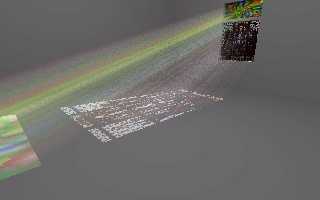 |
 |
|
 |
|
 |
|  |
|  |
|
 |
|
 |
|  |
|  |
|
 |
I solved the missing color problem and will attach the related
code to the end of this message for those who wish to learn from
my mistakes er I mean efforts.
The first observation I have related to the process is make sure you
choose an image that has a low color count and nice bright colors.
Images with sharp contrasts from light to dark in small areas work
poorly. Images with small numbers of uniformly shaded areas work the
best. I believe the reason for this has to do with the way each
color, as it is projected through the media, reacts and scatters
to adjacent paths. If you have too many colors the color information
is lost as it is scattered and mixed with the colors right next to it.
The finer the media particle size you use the less this will occur.
It also adds lifetimes to the render time of the scene.
The example image below show two sections. One is a .png image
I used with the last post that was color corrected to work better
with this last attempt. It still was a poor choice of images and
I know what to look for next time. The top section I added to show
the difference between using an image map and a standered filtered
pigment. The difference is quite noticable and shows that a pigment
related process probably offers the greatest control of the two
methods. One or two renders really is not a fair comparison so
feel free to experiment and decide for your self which works the
best. If you don't like the way I write my code feel free to delete
it from your system. I won't cry or lose any sleep over it.
Cheers,
--
Ken Tyler
mailto://tylereng@pacbell.net
Post a reply to this message
Attachments:
Download 'imapmdia.jpg' (17 KB)
Download 'imapmdia.pov.txt' (5 KB)
Preview of image 'imapmdia.jpg'

|
 |
|  |
|  |
|
 |
|
 |
|  |
|  |
|
 |
Forgot the d_mn image for the image map.
--
Ken Tyler
mailto://tylereng@pacbell.net
Post a reply to this message
Attachments:
Download 'win1.png' (119 KB)
Preview of image 'win1.png'

|
 |
|  |
|  |
|
 |
|
 |
|  |
|  |
|
 |
You can easily see the brightest green light ray is emanating from a
diagonal of green colors seemingly aligning with the cameras viewpoint,
hence less diffusion into other colors. Even those better colors in the
filtered image at top is losing something with the mixing. Who knows
though, maybe this is correct behavior in reality, as you may have
already surmised.
Too bad too, because its that real stained glass image you would want to
do this way. Have to go looking inside some churches to find out what
should be. I think those really colorful light beams are from really
colorful (and large pieced) stained glass windows.
--
omniVERSE: beyond the universe
http://members.aol.com/inversez/homepage.htm
mailto:inv### [at] aol com?Subject=PoV-News com?Subject=PoV-News
Post a reply to this message
|
 |
|  |
|  |
|
 |
|
 |
|  |
|  |
|
 |
Ken
Did you take a look at Johannes Hubert's image as mentioned in a
post a few threads up?
I had it downloaded to read off line and have apparantly read it
(as it's marked as read), but never remember seeing it. I think
that he got some really good sharp results from using what
appeared to be a somewhat simplified method, but understand this
is something to do with the way media/atmosphere works
differently in 3.1.
So after reading you saying that you were giving up with this,
and siing you return to it with vigour, I'm sure we'll se some
spectacular images using this technique soon.
Cheers
Steve
Ken wrote:
>
> I solved the missing color problem and will attach the related
> code to the end of this message for those who wish to learn from
> my mistakes er I mean efforts.
>
> The first observation I have related to the process is make sure you
> choose an image that has a low color count and nice bright colors.
> Images with sharp contrasts from light to dark in small areas work
> poorly. Images with small numbers of uniformly shaded areas work the
> best. I believe the reason for this has to do with the way each
> color, as it is projected through the media, reacts and scatters
> to adjacent paths. If you have too many colors the color information
> is lost as it is scattered and mixed with the colors right next to it.
> The finer the media particle size you use the less this will occur.
> It also adds lifetimes to the render time of the scene.
>
> The example image below show two sections. One is a .png image
> I used with the last post that was color corrected to work better
> with this last attempt. It still was a poor choice of images and
> I know what to look for next time. The top section I added to show
> the difference between using an image map and a standered filtered
> pigment. The difference is quite noticable and shows that a pigment
> related process probably offers the greatest control of the two
> methods. One or two renders really is not a fair comparison so
> feel free to experiment and decide for your self which works the
> best. If you don't like the way I write my code feel free to delete
> it from your system. I won't cry or lose any sleep over it.
>
> Cheers,
>
> --
> Ken Tyler
>
> mailto://tylereng@pacbell.net
>
> -----------------------------------------------------------------
> [Image]
>
> Name: ImapMdia.Pov
> ImapMdia.Pov Type: POV-Ray scene file
(application/x-unknown-content-type-POV-Ray.Scene)
> Encoding: base64
Post a reply to this message
|
 |
|  |
|  |
|
 |
|
 |
|  |
|  |
|
 |
Ken, thanks for the source code.
GrimDude
vos### [at] arkansas net net
Post a reply to this message
|
 |
|  |
|  |
|
 |
|
 |
|  |




![]()